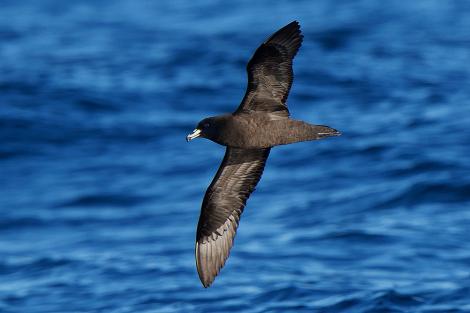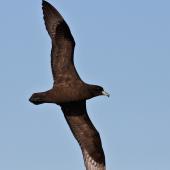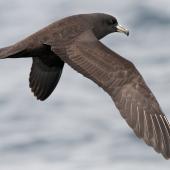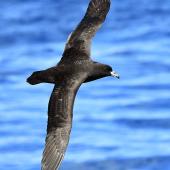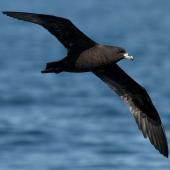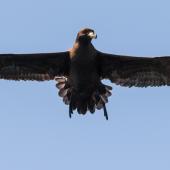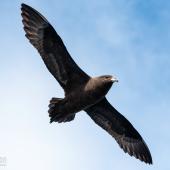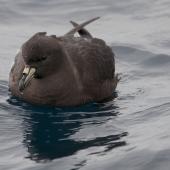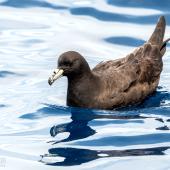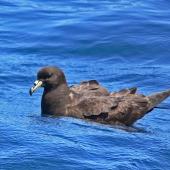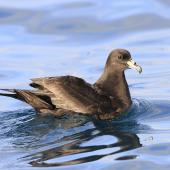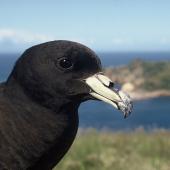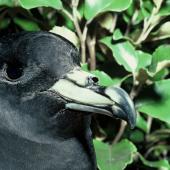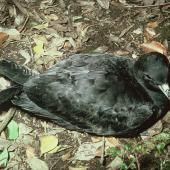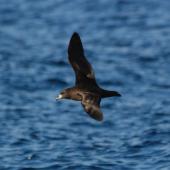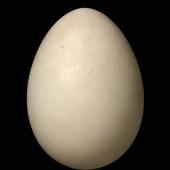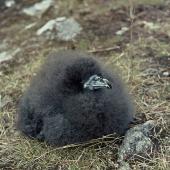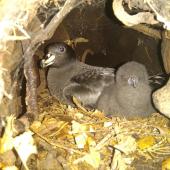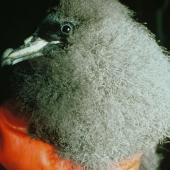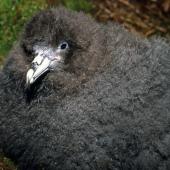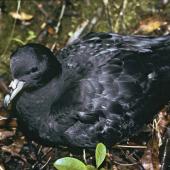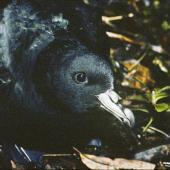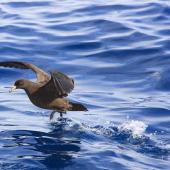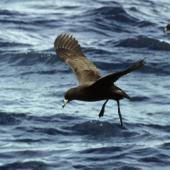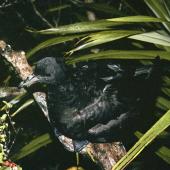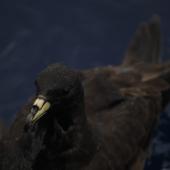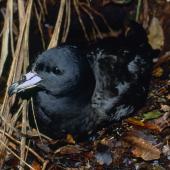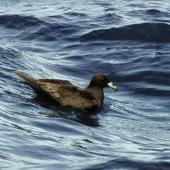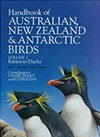Black petrel | Tāiko
Procellaria parkinsoni G.R. Gray, 1862
Order: Procellariiformes
Family: Procellariidae
New Zealand status: Endemic
Conservation status: Nationally Vulnerable
Other names: Parkinson's petrel, tākoketai, taiko, takoketai
Geographical variation: Nil
The black petrel is a familiar petrel of pelagic waters and shelf break edges around northern New Zealand, especially the outer Hauraki Gulf. Generally solitary at sea, it often feeds in small groups associated with dolphins and whales or following fishing vessels. The smallest of the Procellaria group, it is a medium-sized, uniformly black, stocky bird with black legs and feet and a yellowish bill with a grey/black tip. Black petrels usually fly just above the water, but can soar much higher. They breed in burrows on Great Barrier Island (Aotea) and Hauturu/Little Barrier Island in the Hauraki Gulf. The largest colony is on Great Barrier Island which holds an estimated 5000 breeding pairs.
Identification
Black petrels are medium-sized, uniformly black petrels, with black legs and feet and a yellowish bill with a grey/black tip and black between the plates. They are the smallest of the Procellaria petrels. They occasionally show white feathers under the chin or on the head.
Voice: black petrels rarely call at sea, but are vocal on the ground or approaching the colony at night during the breeding season.
Similar species: black petrels are very similar to white-chinned petrel and Westland petrel, which are both larger, bulkier birds with more robust bills. White-chinned petrel also differs in having a straw-coloured bill (no black tip) and (usually) white under the chin. Flesh-footed shearwater commonly occurs alongside black petrels and is smaller, less bulky, with shorter wings, flesh-coloured legs and feet, and a pinkish bill with a dark tip.
Distribution and habitat
Black petrels breed on Great Barrier Island (Aotea) and Hauturu/Little Barrier Island in the Hauraki Gulf, Auckland. They are most often seen in the outer Hauraki Gulf or in pelagic waters near continental shelf breaks or sea mounts. During the breeding season, black petrels occur in subtropical waters around New Zealand, eastern Australia and the Pacific Islands. Black petrels migrate to South American waters during the non-breeding period, congregating in offshore and pelagic waters off Ecuador. During the non-breeding season, black petrels have been reported off the coasts of Panama, Costa Rica, Guatemala, Mexico and Galapagos.
Population
The largest population of black petrels is on Great Barrier Island (Aotea), with 5,000 breeding pairs estimated and about 10,000 non-breeding birds. The Hauturu/Little Barrier Island colony is estimated at 600 breeding pairs. At-sea counts have estimated 38,000 black petrels present in eastern tropical Pacific waters, which is approximately double the estimated population size based on counts undertaken at the two known breeding locations.
Threats and conservation
Black petrels formerly bred throughout the North Island and northwest Nelson, but have been extirpated from mainland New Zealand due to the introduction of feral cats, feral pigs, mustelids and rats. The colony on Hauturu/Little Barrier Island has no land-based threats (apart from fire) as this is a legally protected, predator-free island sanctuary with restricted access. There are feral pigs, feral cats, ship rats and kiore on Great Barrier Island (Aotea), most of which have been recorded at the main breeding colony on Mount Hobson/Hirakimata. Black petrels have been caught by commercial and recreational fishers both in New Zealand and overseas and are recognised as the most at-risk seabird in New Zealand from commercial fishing.
Few conservation actions have specifically targeted black petrels. A translocation of 100 juveniles from Great Barrier Island (Aotea) to Hauturu/Little Barrier Island occurred in 1989 and 1990, but with limited success. The Great Barrier Island (Aotea) population has been intensively monitored since 1995. Mitigation to reduce seabird bycatch has been put in place on commercial fisheries vessels operating within New Zealand.
Breeding
Black petrels are colonial breeders, nesting in short to medium (0.5-3 m) burrows on Great Barrier Island (Aotea) and Hauturu/Little Barrier Island. They are monogamous, with shared incubation and chick care. Black petrels attend the colony from October to July, with a single egg laid from mid-November to late January. Incubation is shared and takes 57 days. Chicks are left unattended during daylight when 3-7 days old. One or both parents visit every 2-3 nights and feed the chick by regurgitation through to fledging at 96 to 122 days old. Young birds return to the colonies when 4-6 years old and first breed when 5-7 years old.
Behaviour and ecology
Black petrels are generally solitary at sea, but sometimes form flocks around fishing vessels or in association with cetaceans. They characteristically feed by surface feeding and shallow diving at night. Black petrels excavate their own burrows, or utilise caves, hollow logs and cavities under banks and bases of trees. They breed as monogamous pairs, which typically remain together throughout their breeding lives. Black petrels visit the breeding colonies after dark and depart before dawn, or stay in burrows during daylight. After breeding, they migrate to South America, staying in eastern tropical Pacific waters from July to October.
Black petrels rarely call at sea, but are vocal on the ground or approaching the colony at night during the breeding season. When on the ground at the colony, males have a loud, harsh, far-carrying call described as a ‘Clack’; this repeated call peaks just after dark and before dawn and appears to be used to attract females to the burrow location. Females have an ‘Aerial’ call; usually on approach to and above the colony. On the ground, both birds have ‘Squawk’ call when threatened or during territorial disputes and ‘Crooning’ calls when males and females are bonding in the burrow together or bonding with the chick.
Food
Black petrels feed predominately at night on bioluminescent squid (particularly Ommastrephidae, Histioteuthidae and Cranchidae) supplemented by fish, tunicates, crustaceans and cyclostomes.
Weblinks
http://www.nzbirds.com/birds/blackpetrel.html
References
Bell, E.A.; Sim, J.L. 1998a. Survey and monitoring of black petrels on Great Barrier Island 1996. Science for Conservation: 77. Department of Conservation, Wellington.
Bell, E.A.; Sim, J.L. 1998b. Survey and monitoring of black petrels on Great Barrier Island 1997. Science for Conservation 78. Department of Conservation, Wellington.
Bell, E.A.; Sim, J.L. 2000a. Survey and monitoring of black petrels on Great Barrier Island 1997/98. Published client report on contract 3085, funded by Conservation Services Levy. Department of Conservation, Wellington. 24 p.
Bell, E.A.; Sim, J.L. 2000b. Survey and monitoring of black petrels on Great Barrier Island 1998/99. Published client report on contract 3089, funded by Conservation Services Levy. Department of Conservation, Wellington. 23 p.
Bell, E.A.; Sim, J.L. 2000c. Survey and monitoring of black petrels on Great Barrier Island 1999/2000. Published client report on contract 3018, funded by Conservation Services Levy. Department of Conservation, Wellington. 30 p.
Bell, E.A.; Sim, J.L. 2002. Survey and monitoring of black petrels on Great Barrier Island 2000/01. DOC Science Internal Series 48. Department of Conservation, Wellington. 24 p.
Bell, E.A.; Sim, J.L. 2003a. Survey and monitoring of black petrels on Great Barrier Island 2001/02. DOC Science Internal Series 134. Department of Conservation, Wellington. 24 p.
Bell, E.A.; Sim, J.L. 2003b. Survey and monitoring of black petrels on Great Barrier Island 2002/03. DOC Science Internal Series 135. Department of Conservation, Wellington. 28 p.
Bell, E.A.; Sim, J.L. 2005. Survey and monitoring of black petrels on Great Barrier Island 2003/04. DOC Research and Development Series 213. Department of Conservation, Wellington. 27 p.
Bell, E.A.; Sim, J.L.; Scofield, P. 2007. Demographic parameters of the black petrel (Procellaria parkinsoni). DOC Research and Development Series 273. Department of Conservation, Wellington. 32 p.
Bell, E.A.; Sim, J.L.; Scofield, P. 2009. Population parameters and distribution of the black petrel (Procellaria parkinsoni), 2005/06. DOC Research and Development Series 307. Department of Conservation, Wellington. 47 p.
Bell, E.A.; Sim, J.L.; Scofield, P. 2011. Population parameters and distribution of the black petrel (Procellaria parkinsoni) on Great Barrier Island (Aotea Island), 2007/08. DOC Marine Conservation Services Series 8. Department of Conservation, Wellington. 37 p.
Bell, E.A.; Sim, J.L.; Scofield, P. 2011. Population parameters and distribution of the black petrels (Procellaria parkinsoni) on Great Barrie rIsland (Aotea Island), 2008/09. Published client report funded by Conservation Services Levy. Department of Conservation, Wellington. 41 p.
Bell, E.A.; Sim, J.L.; Scofield, P.; Francis, C. 2011. Population parameters of the black petrels (Procellaria parkinsoni) on Great Barrier Island (Aotea Island), 2009/10. Draft report. Conservation Services Programme, Department of Conservation, Wellington.
Bell, E.A.; Sim, J.L.; Torres, L.; Schaffer, S. 2014 draft report. At-sea distribution of the black petrels (Procellaria parkinsoni) on Great Barrier Island (Aotea Island), 2009/10: Part 1 – Environmental variables. DOC Marine Conservation Series. Department of Conservation, Wellington.
Bell, E.A.; Sim, J.L.; Abraham, E.; Torres, L.; Schaffer, S. 2014 draft report. At-sea distribution of the black petrels (Procellaria parkinsoni) on Great Barrier Island (Aotea Island), 2009/10: Part 2 – Overlap with fisheries. DOC Marine Conservation Series. Department of Conservation, Wellington.
Bell, E.A.; Sim, J.L.; Scofield, P. 2011. Monitoring the population parameters of the black petrels (Procellaria parkinsoni) on Great Barrier Island (Aotea Island), 2010/11. Unpublished report prepared for Department of Conservation, Great Barrier Field Centre, Great Barrier Island.
Bell, E.A.; Sim, J.L.; Scofield, P. 2012. Monitoring the population parameters of the black petrels (Procellaria parkinsoni) on Great Barrier Island (Aotea Island), 2011/12. Unpublished report prepared for Department of Conservation, Great Barrier Field Centre, Great Barrier Island.
Freeman, R.; Dennis, T.; Landers, T.; Thompson, D.; Bell, E.; Walker, M.; Guildford, T. 2010. Black petrels (Procellaria parkinsoni) patrol the ocean shelf-break: GPS tracking of a vulnerable procellariiform seabird. PLoS ONE 5: e9236.
Francis, R.I.C.C.; Bell, E.A. 2010. Fisheries risks to population viability of black petrel (Procellaria parkinsoni). New Zealand Aquatic Environment and Biodiversity Report No. 51. Ministry of Fisheries,Wellington.
Heather, B.D.; Robertson, H.A. 1996. Field guide to the birds of New Zealand. Penguin Book (NZ) Ltd, Auckland,New Zealand. 432 p.
Hunter, C.; Fletcher, D.; Scofield. P. 2001. Preliminary modelling of black petrels (Procellaria parkinsoni) to assess population status. DOC Science Internal Series 2. Department of Conservation,Wellington,New Zealand. 42 p.
Imber, M.J. 1976. Comparison of prey of the black Procellaria petrels of New Zealand. New Zealand Journal of Marine and Freshwater Research 10: 119-30.
Imber, M.J. 1987. Breeding ecology and conservation of the black petrel (Procellaria parkinsoni). Notornis 34: 19-39.
Imber, M.J.; McFadden, I.; Bell, E.A.; Scofield, R.P. 2003. Post-fledging migration, age of first return and recruitment, and results of inter-colony translocation of black petrels (Procellaria parkinsoni). Notornis 50: 183-190.
Marchant, S.; Higgins, P.J. (eds). 1990. Handbook of Australian, New Zealand and Antarctic Birds.Vol. 1, ratites to ducks. Oxford University Press. Melbourne.
Medway, D.G. 2002. An historic record of black petrels (Procellaria parkinsoni) nesting in South Westland. Notornis 49: 51-52.
Pitman, R.L.; Balance, L.T. 1992. Parkinson’s petrel distribution and foraging ecology in the eastern pacific: aspects of an exclusive feeding relationship with dolphins. Condor 94: 825-835.
Richard, Y.; Abraham, E.R.; Filippi, D. 2011. Assessment of the risk to seabird populations from New Zealand commercial fisheries. Final Research Report for Ministry of Fisheries projects IPA2009/19 and IPA2009/20. Ministry of Fisheries, Wellington. 137 p.
Robertson, C.J.R.; Bell, E.A.; Scofield, P. 2003. Autopsy report for seabirds killed and returned from New Zealand fisheries, 1 October 2000 to 30 September 2001: birds returned by Ministry of Fisheries observers to the Department of Conservation. DOC Internal Series 96. Department of Conservation, Wellington. 36 p.
Robertson, C.J.R.; Bell, E.A.; Scofield, P. 2004. Autopsy report for seabirds killed and returned from New Zealand fisheries, 1 October 2001 to 30 September 2002: birds returned by Ministry of Fisheries observers to the Department of Conservation. Department of Conservation Internal Series 155. Department of Conservation, Wellington. 43 p.
Rowe, S.J. 2009. Conservation Services Programme Observer Report: 1 July 2004 to 30 June 2007. Department of Conservation Marine Conservation Services Series 1. Department of Conservation, Wellington. 93 p.
Rowe, S. 2010. Level 1 Risk Assessment Methodology for incidental seabird mortality associated with New Zealand fisheries in the NZ-EEZ. Unpublished report to the Seabird Stakeholder Advisory Group. Department of Conservation, Wellington.
Rowe, S.J. 2010. Conservation Services Programme Observer Report: 1 July 2007 to 30 June 2008. Department of Conservation Marine Conservation Services Series 4. Department of Conservation, Wellington. 97 p.
Scofield, R.P. 1989. Breeding biology and conservation of the black petrel (Procellaria parkinsoni) on Great Barrier Island. Unpublished MSc (Zoology) thesis. Auckland University, Auckland, New Zealand. 69 p.
Spear, L.B.; Ainley, D.G.; Webb, S.W. 2005. Distribution, abundance, habitat use and behaviour of three Procellaria petrels off South America. Notornis 52: 88–105.
Thompson, D. 2010a. Autopsy report for seabirds killed and returned from New Zealand fisheries, 1 October 2006 to 30 September 2007: birds returned by Ministry of Fisheries observers to the Department of Conservation. Department of Conservation Marine Conservation Services Series 3. Department of Conservation, Wellington. 37 p.
Thompson, D. 2010b. Autopsy report for seabirds killed and returned from New Zealand fisheries, 1 October 2007 to 30 September 2008: birds returned by Ministry of Fisheries observers to the Department of Conservation. Department of Conservation Marine Conservation Services Series 5. Department of Conservation, Wellington. 33 p.
Thompson, D. 2010c. Autopsy report for seabirds killed and returned from New Zealand fisheries, 1 October 2008 to 30 September 2009: birds returned by Ministry of Fisheries observers to the Department of Conservation. Department of Conservation Marine Conservation Services Series 6. Department of Conservation, Wellington. 37 p.
Recommended citation
Bell, E.A. 2013 [updated 2022]. Black petrel | Tāiko. In Miskelly, C.M. (ed.) New Zealand Birds Online. www.nzbirdsonline.org.nz
Black petrel | Tāiko
- Social structure
- monogamous
- Breeding season
-
- Jul
- Aug
- Sep
- Oct
- Nov
- Dec
- Jan
- Feb
- Mar
- Apr
- May
- Jun
- Nest type
- burrow
- Nest description
- Burrow 0.5 to 3 metres deep, nest on raised dish inside the chamber.
- Nest height (mean)
- 0 m
- Maximum number of successful broods
- 1
- Clutch size (mean)
- 1
- Mean egg dimensions (length)
- 70 mm
- Mean egg dimensions (width)
- 50 mm
- Egg colour
- White
- Egg laying dates
-
- Jul
- Aug
- Sep
- Oct
- Nov
- Dec
- Jan
- Feb
- Mar
- Apr
- May
- Jun
- Interval between eggs in a clutch
- Not applicable days
- Incubation behaviour
- shared
- Incubation length (mean)
- 57 days
- Nestling type
- semi-precocial
- Nestling period (mean)
- 96-122 days
- Nestling period (min)
- 96 days
- Nestling period (max)
- 122 days
- Age at fledging (mean)
- 96-122 days
- Age at fledging (min)
- 96 days
- Age at fledging (max)
- 122 days
- Age at independence (mean)
- 96-122 days
- Age at independence (min)
- 96 days
- Age at independence (max)
- 122 days
- Age at first breeding (typical)
- 6 years
- Age at first breeding (min)
- 5 years
- Maximum longevity
- 29 plus years
- Maximum dispersal
- 11,000 km




